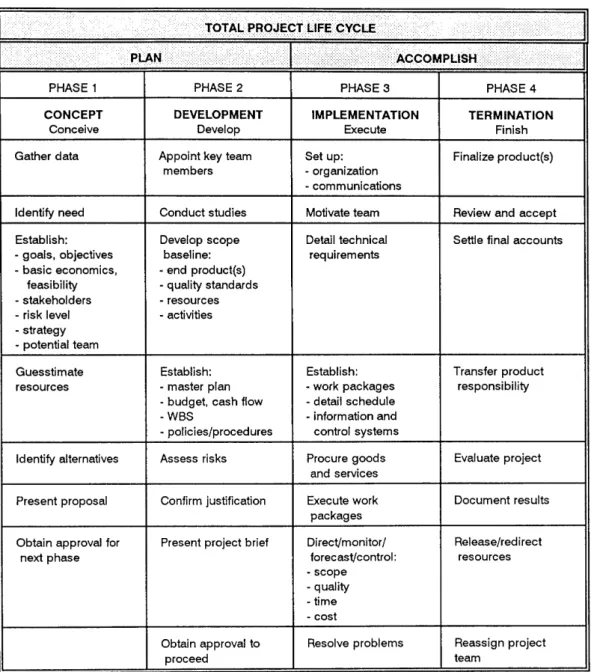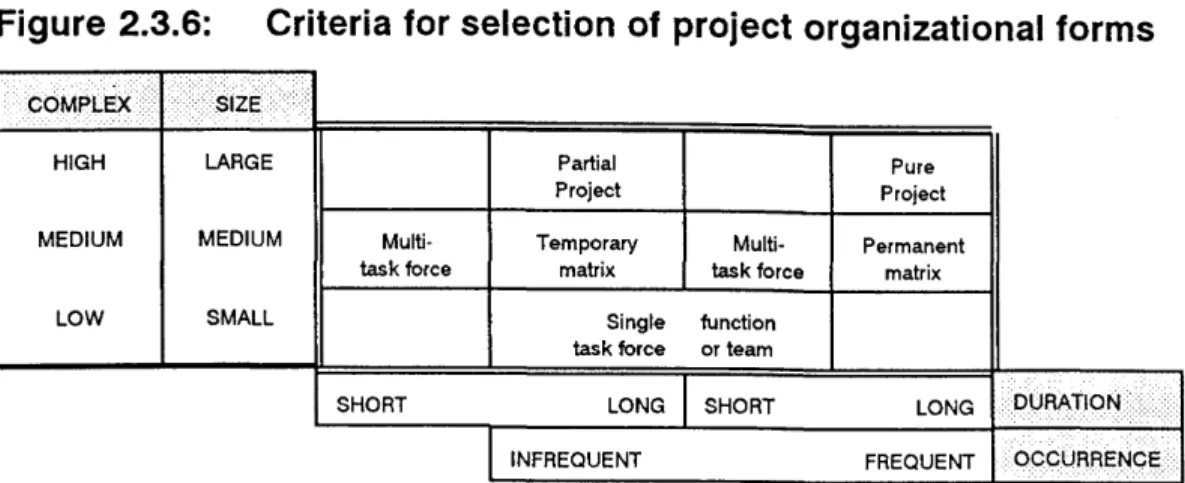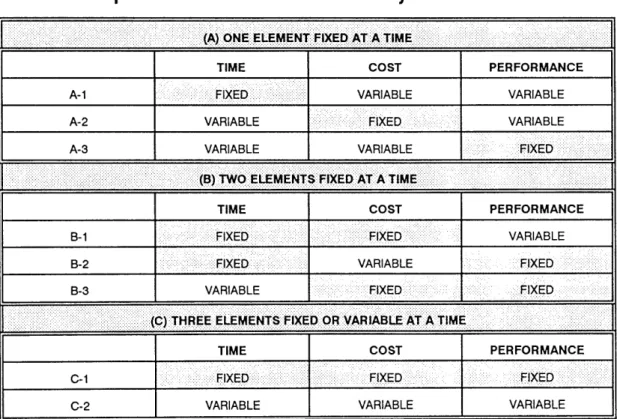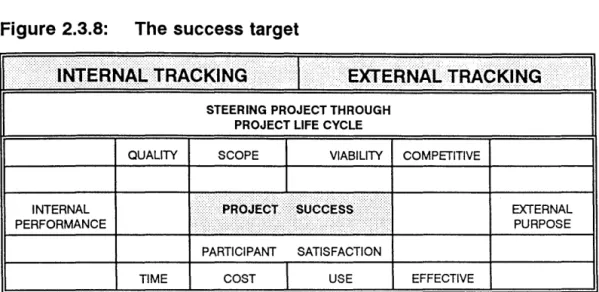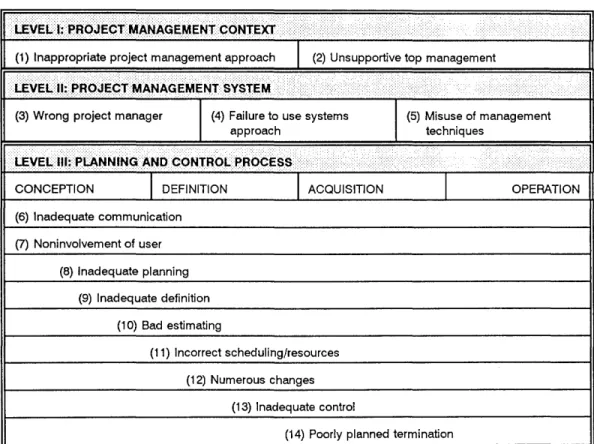In this second part of the literature review, the discussion of formalized project management begins in subsection 2.3.2 with the definition of a project. Applications and different forms of project management are presented in subsection 2.3.14 and finally subsection 2.3.15 summarizes section 2.3 of the literature review. It proposes an anatomy of the project life cycle (shown in Figure 2.3.1), where from a macro view the plan itself and the next level (stage) are generic to all projects, but if we move down to the micro view, the third level (stage) is the industry.
Finally, it should be noted that the proper and consistent application of management at all levels of the project life cycle is greatly improved by dividing a project into different phases. As indicated in section 2.3.2, the focus of project management is on managing projects. In support of his argument, he contrasts some of the characteristics of a well-run production or service organization with those of a project environment.
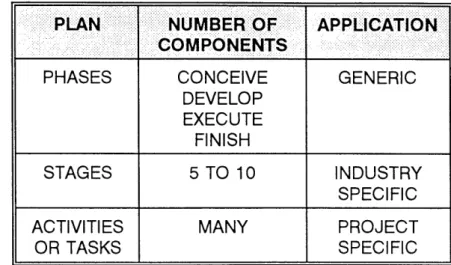
Objectives of project management
The cost parameter, which is the specified or allowable cost for the project or target cost for the work to be done. Closely related to the objectives of project management is the idea of project success and successful project management. Nicholas identifies three main elements or key characteristics that distinguish project management from earlier traditional forms of management.
The project manager is responsible for the entire project and must be fully committed to achieving its goals. The project management system - which includes the organizational structure, the information processing system and the practices and procedures that allow the integration of the vertical and horizontal elements of the project organization. The main elements of project management, which will be described in the next three subsections, are based on the main features of project management as proposed by Nicholas (1990) and embodied in Kerzner's (1979) guiding factors.
The project manager
- The role of the project manager
- The responsibilities of the project manager
- The interface role of the project manager
- The skill requirements for the project manager
- Leadership of the project manager
The project manager is driven to acquire resources, facilities and people to start and ultimately complete the project. Zuberi in the PMI paper in Wideman (1991: V-2) also elaborates on the various roles of the project manager. The position of project manager is temporary, superimposed on the existing structure and therefore not familiar with the same amount of leverage that legal authority gives through hierarchical position.
The project manager should further familiarize himself with the operations of each line organization and also have general knowledge of the technology. The relative intensity of these conflicts can vary over the life cycle of the project. Thus, the project manager must avoid the detrimental aspects of conflict, but maximize the potentially beneficial aspects.
The project team
- The members of the project team
- Staffing the project team
- The functional members of the project team
- The roles outside the project team
- Project organizations
- Organizational structures
- The development of the matrix structure
- The matrix organizational structure
- The selection of an organizational structure
- Converting to a new organizational structure
Kerzner also lists some of the expectations the project team has of their team leader, the project manager. The project office is an organization developed to support the project manager in the performance of his duties. Organizing and staffing the project office and project team in a project environment (which is by definition a temporary situation) can become complex.
Kerzner further notes that the project management process itself can cause problems during the staffing process. The project manager must therefore have delegated authority to enforce policies, procedures, rules and standards. Ultimately, however, the person who has the most influence in the staffing phase is the project manager himself.
The personal traits and abilities of the project manager will attract or discourage highly sought after individuals who work with a particular project manager. Functional members report both horizontally to the project manager and vertically to their functional heads. For the project manager and project team to function effectively, a project management system is necessary (Nicholas.
It then became clear that control of a project had to be given to staff whose first loyalty was to the completion of the project. The biggest disadvantage of the project organization form was the cost of maintaining the organization. Three common variations of the pure project structure are (1) the project center (where the structure of the parent organization remains the same except for the addition of a separate project .. and manager), (2) the stand-alone project (where a new organization becomes created from various participating organizations, especially with the aim of achieving the project), and (3) the partial project (where certain functions of critical importance for the project are assigned to the project manager while other, support-oriented functions within the functional areas in ' a parent organization).
The primary effort of the project manager (also referred to as the matrix manager) is integration. Management goals may differ from project goals if top management is not involved in defining project requirements at the planning stage. Complexity of relationships including the number of functional areas involved in the project and the degree of interdependence.

The functions of project management
- Internal interfaces
- External interfaces
- Trade-off analysis in the project environment
- Project failure
- Successful project management
- Advantages of project management
- Disadvantages of project management
The executive must clearly demonstrate support for the project management concept through active sponsorship and control. No major technical, cost, schedule or performance decision should be made without the participation of the project manager. Therefore, the focus of project management should be on enhancing the quality of each participant's experience at each stage of the project.
Therefore, the project manager's focus is not limited to internal considerations, but must also be external. The wrong organizational structure, project manager, or project team has been selected to meet the project's requirements. The person in the role of project manager does not have the background, skills, experience or personality to lead the project.
The elements and processes of the project throughout the project life cycle are compartmentalized without regard to their interaction. Wideman (1991: C-3) identifies certain pitfalls to avoid when using the project management approach. The project manager must be committed to meeting the time, cost, safety and quality objectives.
The user must have a strong commitment to the project goals and must be involved in the project management process until final approval of the installed final element. Good communication means a mechanism for the effective integration of the efforts of the project participants and enabling the management of the project and the system development process. There must be constant communication between all personnel within the project/user/top level management team.
There should be a complete and clear definition of the project scope, objectives and the work to be done. Environmental events: The likelihood that external organizational and environmental factors affect the project team's operations either negatively or positively. Urgency: the perception of the importance of the project or the need to complete the project as soon as possible.
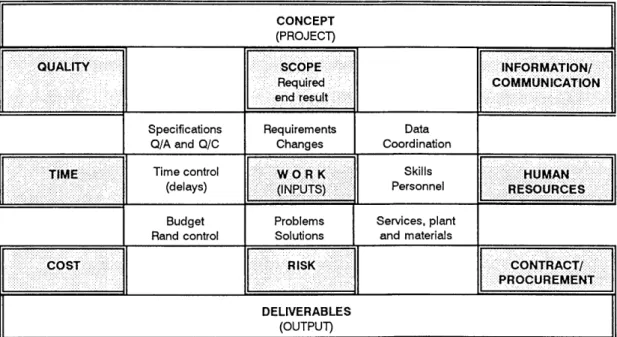
Applications and forms of project management
- Criteria for the application of project management
- Industry application of project management
- Different forms of project management
Stuckenbruck suggests that by examining the characteristics of a particular effort, it can be determined whether the application or performance of project management will be appropriate or not. Projects are not an integral part of the organization's operations and do not require project management techniques. The unit is small and the same results can be achieved through the functional organization, although informal project management techniques can be used.
Project management has found diverse applications (Welsh, 1992: 5) and is used in many different industries or technologies. Organizations that have complex tasks and operate in a dynamic operational environment typically find formal project management mandatory. Industries with simple tasks, which are in static or dynamic operational environments (type A and B industries), usually have no need for formalized project management.
Not all projects have the same project management requirements and therefore cannot be managed identically. There is also a poor understanding of project management and a reluctance to invest in proper training of staff. There is a heavy reliance on subcontractors and external consultants or agencies for project management expertise.
Informal project management is generally used in non-project oriented organizations with functional (traditional) or pure management. Pure project management: A complete, self-sufficient organization is created with all the necessary functional elements. Program management is used interchangeably with project management due to the similarities between programs and projects.
Project management resembles a type of management used in consumer-oriented firms to generate new products or markets.
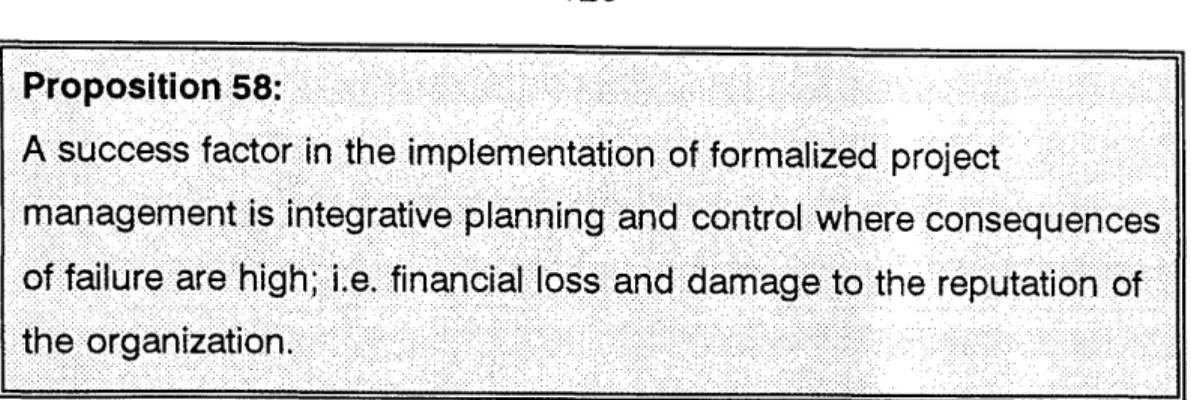
Summary
They act as staff leaders and their goal is to achieve unity of control over project activities. For the purposes of this study, formalized project management is defined as and refers to the application of basic project management in the form of matrix management in government/non-profit project environments. The type of project manager involved is a matrix and pure project manager as defined in section 2.3.14.3.
Project management is defined as a systems approach to planning, organizing, directing and controlling human and material resources for the duration of a project established to achieve and complete the project objectives. A management-by-objective (MBO) approach can be used to achieve the overarching goal of a project. The tools for implementing formalized project management are embodied in the three main elements of project management, namely the project manager, the project team and the project management system.
Skills in interface management and conflict resolution are seen as critical elements of the leadership role required of the project manager. The project team, with the project manager as team leader, consists of a combination of project office personnel and functional employees. Project office personnel provide support to the project manager, while functional members are usually assigned only to a specific phase of the project.
Roles outside the project team that are also important are the project manager role and the top management role. The project management system must ensure that the project manager and project team function effectively. While many different structures can be identified, the matrix form is considered most suitable for project management.
The four core functions scope, quality, time and cost management lead to the specific project goals, but must be integrated with each other and with the project's life cycle.
